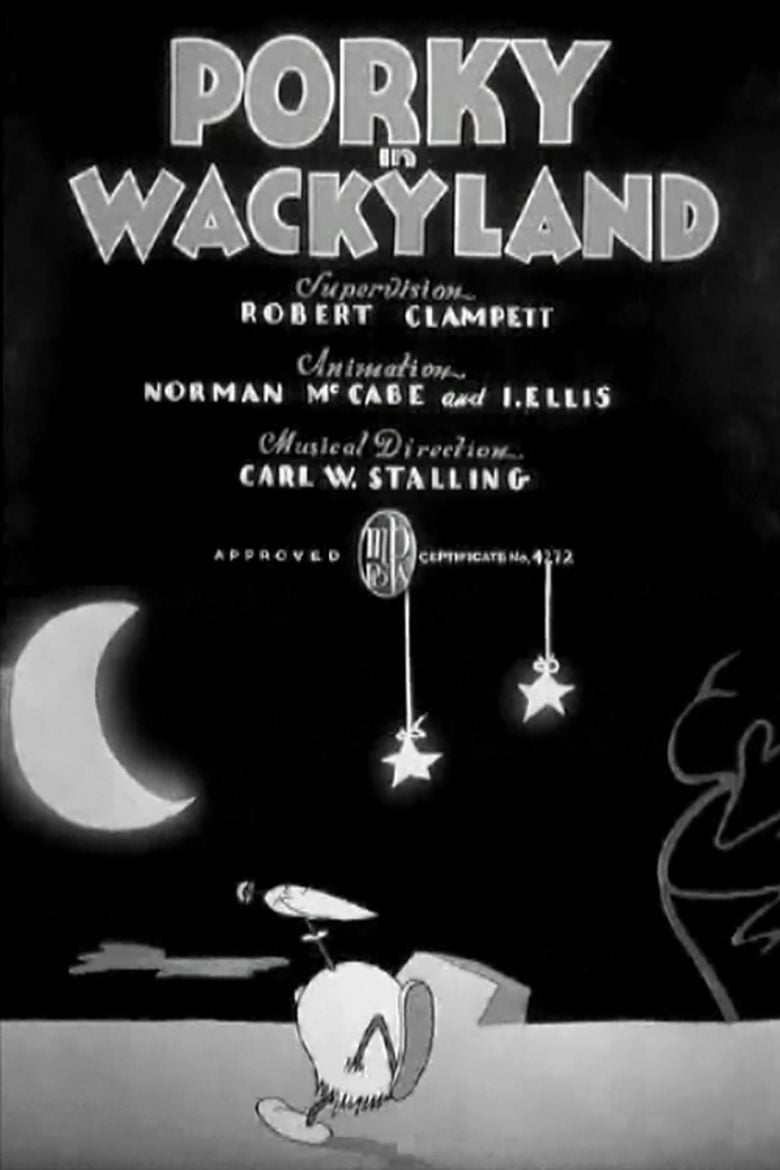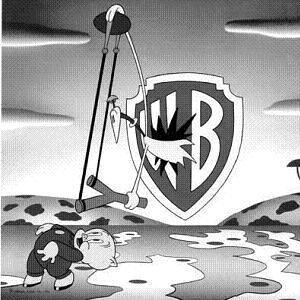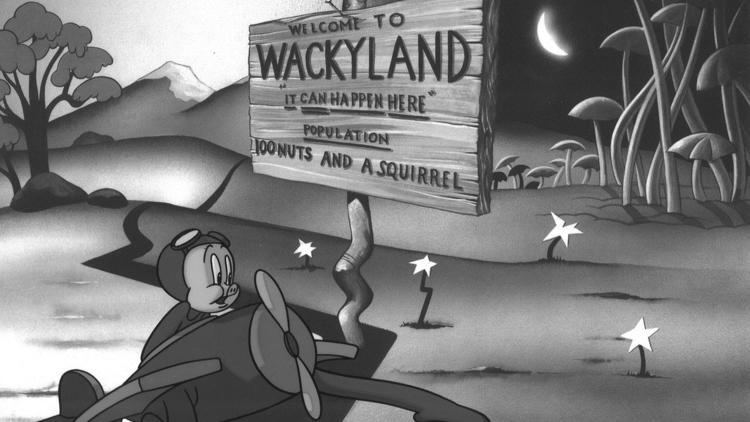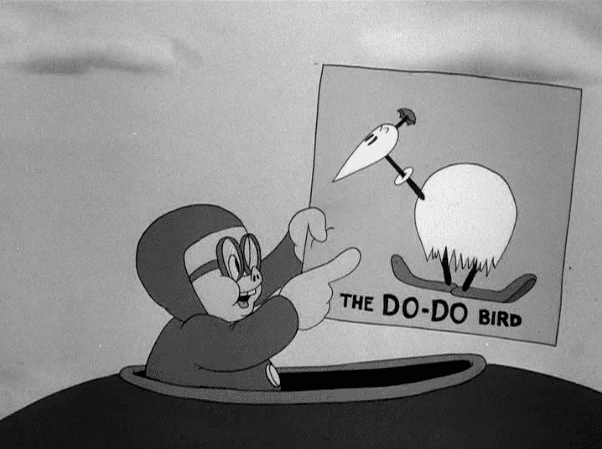Porky in Wackyland
8 /10 1 Votes
Director Robert Clampett Film series Looney Tunes | 7.8/10 IMDb Genre Animation, Short, Comedy Music director Carl Stalling Duration | |||||||||||||||||||||||||||||||||
 | ||||||||||||||||||||||||||||||||||
Release date September 24, 1938 (USA) Similar movies The Scarlet Pumpernickel , Porky Pig's Feat , Duck Dodgers and the Return of the 24½th Century , Bugs vs. Daffy: Battle of the Music Video Stars , Carnival of the Animals , Duck Dodgers in the 24½th Century | ||||||||||||||||||||||||||||||||||
Porky in wackyland x dough for the do do
Porky in Wackyland is a 1938 animated short film, directed by Robert Clampett for Leon Schlesinger Productions as part of Warner Bros.' Looney Tunes series.
Contents
- Porky in wackyland x dough for the do do
- Porky in wackyland 1938 warner bros extraits th me de l mission les tontons scalpeurs
- Plot
- Follow ups and derivative works
- References

In this film Porky Pig goes hunting through a Salvador Dalí-esque landscape to find the Do-Do Bird for a very large bounty. In 1994 it was voted #8 of The 50 Greatest Cartoons of all time by members of the animation field and in 2000 was deemed "culturally, historically, or aesthetically significant" by the United States Library of Congress and selected the short for preservation in the National Film Registry.

Porky in wackyland 1938 warner bros extraits th me de l mission les tontons scalpeurs
Plot

A newspaper shows Porky traveling to Africa to hunt the rare dodo bird, worth four sextillion dollars. Porky uses his airplane to go to Dark Africa, then Darker Africa, and finally lands in Darkest Africa. When Porky lands, a sign tells him that he's in Wackyland ("Population: 100 nuts and a squirrel"), while a voice booms out "It can happen here!" Porky tiptoes along the ground in his airplane and he is greeted by a roaring beast, who suddenly becomes effeminate and dances away into the forest.

He watches as the sun is lifted above the horizon by a tower of stacked creatures. Nearby, another creature rises out of a tall flower, playing "The William Tell Overture", using his nose as a flute. The creature launches into a wild drum solo, plays a tiny piano, and plays its nose like a horn, which brings out a group of odd creatures, including a rabbit dangling in midair from a swing that seems to be threaded through its own ears, a small creature wearing large boots that encourages the rabbit to swing faster, a peacock with a fantail of cards, an upside-down creature walking with giant bare feet in his hands, a goofy looking creature wearing large glasses in a small pot, a little creature wearing oversized female mannequin legs, and an angry criminal imprisoned behind a free-floating barred window that he holds in his hands while a small policeman on a wheel appears and hits him on the head with a large stick. As Porky tries to find the do-do, he is distracted by a duck singing "Mammy!", a horn-headed creature, a conjoined cat and dog hybrid creature spinning around like a tornado while they fight, and a 3 headed stooge whose heads argue and fight amongst themselves, but temporally stop their fight to tell the viewers that their mother was scared by a pawnbreaker's sign, while a small creature with a light bulb on its head translates their gibberish speech.

Finally, the Dodo appears. Porky tries to catch it, but it plays tricks on him. The dodo pulls out a pencil and draws a door in mid-air, and instead of opening it and running through, reaches down and lifts up the bottom edge of the door like a curtain, darts underneath and lets it snap back into place for Porky to bump into. At another point, the do-do appears on the Warner Bros. shield logo and slingshots Porky into the ground. Afterwards, the dodo pulls a wall of bricks in the picture and lets him crash into it. Eventually, Porky triumphs when he disguises himself as a bearded paperboy, shouting "Extra! Extra! Porky captures Dodo!", before hitting the bird with a mallet. Porky loudly proclaims to the audience that he has captured the last dodo. The dodo mockingly replies, "Yes, I'm really the last of the dodos. Ain't I, fellas?". A multitude of dodos appear, all yelling out, "Yeah, man!". They and the Dodo all howl, which allows him to escape and stand on Porky's head.
Follow-ups and derivative works

Much of the Wackyland sequence was adapted and reused by Clampett for inclusion in his 1943 short Tin Pan Alley Cats. A color remake of Porky in Wackyland was supervised by Friz Freleng in 1948. Re-titled as Dough for the Do-Do, the remake was released in 1949. The films were nearly identical, in many cases appearing to match frame-by-frame in certain details, albeit with Porky's appearance updated (by redoing most of the animation of the character), the voices having evolved (with less use of speeding-up) and all of the backgrounds being different. The following differences include:
Dough for the Do-Do was produced in Technicolor, but was originally released in Cinecolor due to a dispute with the Technicolor corporation. Later reissues were printed by Technicolor.
There were at least two Terrytoons plagiarizations of Porky in Wackyland in the 1940s or 50's. Dingbat Land (1949) starred Sourpuss and Gandy Goose. The role of the Do-Do was taken by a minor Terry character, Dingbat. The second film, a more direct plagiarization of the Porky Pig/Do-Do cartoons, starred a British hunter and a Do-Do stand-in. The creature didn't talk, but made strange hooting noises, and flung flames from a tuft of hair on top of its head.
Tex Avery, for whom Clampett worked as an animator in the mid-1930s, borrowed strongly from this cartoon for his 1948 MGM cartoons Half-Pint Pygmy (in which the characters, George and Junior, travel to Africa in search of the world's smallest pygmy, only to discover that he has an uncle who's even smaller) and The Cat That Hated People (where the cat travels to the moon and encounters an array of characters similar to those in Clampett's Wackyland, e.g., a pair of gloves and lips that keep saying "Mammy, mammy", just like the Al Jolson duck in Porky in Wackyland). Clampett would again use the Three Stooges parody when a later creation of his, Beany and Cecil, faced the "Dreaded Three-Headed Threep".
According to writer Paul Dini, the Do-Do Bird is the father of Gogo Dodo, a character on the 1990s animated TV series Tiny Toon Adventures. A small clip from the film was used in a Slappy Squirrel segment on another Warners animated TV series of the 1990s, Animaniacs. The segment, titled "Critical Condition", featured Porky in Wackyland as part of a fake Laserdisc release. The Do-Do Bird has made occasional guest spots in the DC Comics Looney Tunes comic book, being colored in grayscale as opposed to the rest of the art being in color. The character makes an appearance in the Wii game Looney Tunes: Acme Arsenal as an unplayable character. He is given a first name, Yoyo the Dodo. The character can also be seen in the beginning of Who Framed Roger Rabbit.
The "dodo bird" in this cartoon bears more than a passing resemblance to the metal eating bird that appears in "It's A Bird", a stop-motion animation short by Charles Bowers.
Animator Jeff Hale may have borrowed Wackyland and Dodo's concept of the main character in a strange world surrounded by strange creatures for a Sesame Street cartoon segment featuring a boy on a bicycle suddenly riding into a Wackyland-esque neighborhood filled with very odd creatures and things, making him think he's lost, until a strange man with a magic yoyo appears and gives him a clue how to find his way back home: "Try to remember all the things you passed/But when you go back, make the first thing the last."
References
Porky in Wackyland WikipediaPorky in Wackyland IMDb Porky in Wackyland themoviedb.org
